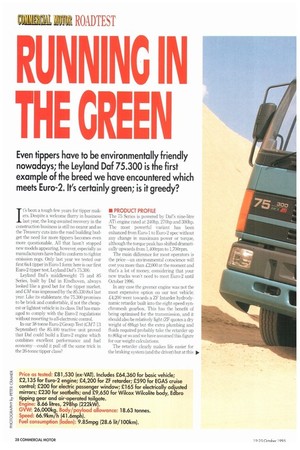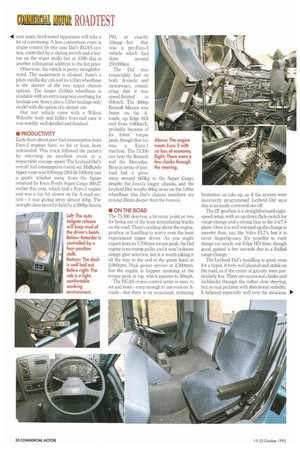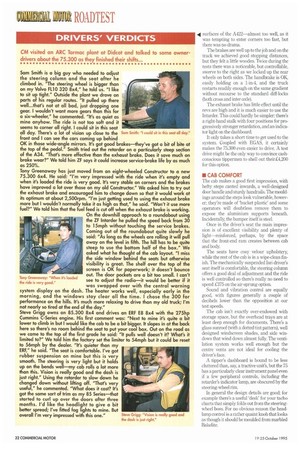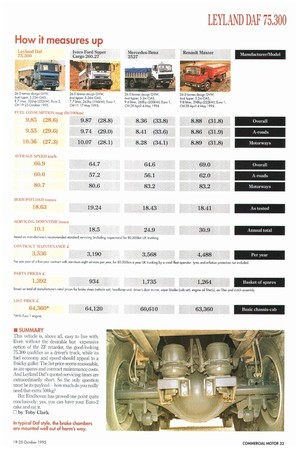RUNNING IN THE GREEN
Page 30

Page 32

Page 34

Page 35

If you've noticed an error in this article please click here to report it so we can fix it.
Even tippers have to be environmentally friendly nowadays; the Leyland Dot 75.300 is the first example of the breed we have encountered which meets Euro-2. It's certainly green; is it greedy?
Ies been a tough few years for tipper makers. Despite a welcome flurry in business last year, the long-awaited recovery in the construction business is still no nearer and as the Treasury cuts into the road building budget the need for more tippers becomes even more questionable. All that hasn't stopped new models appearing, however, especially as manufacturers have had to conform to tighter emission regs. Only last year we tested our first 6x4 tipper in Euro-1 form: here is our first Euro-2 tipper test, Leyland Des 75300.
Leyland Daf's middleweight 75 and 85 Series, built by Daf in Eindhoven, always looked like a good bet for the tipper market, and CM was impressed by the 85.330 8x4 last year. Like its stablemate, the 75300 promises to be brisk and comfortable, if not the cheapest or lightest vehicle in its class. Daf has managed to comply with the Euro-2 regulations without resorting to all-electronic control.
In our 38-tonne Euro-2 Group Test (GM 7-13 September) the 85.400 tractive unit proved that Daf could build a Euro-2 engine which combines excellent performance and fuel economy—could it pull off the same trick in the 26-tonne tipper class? • PRODUCT PROFILE The 75 Series is powered by Daf's nine-litre ATi engine rated at 240hp, 270hp and 300hp. The most powerful variant has been enhanced from Euro-1 to Euro-2 spec without any change in maximum power or torque, although the torque peak has shifted dramatically upwards from 1,400rpm to 1,700rpm.
The main difference for most operators is the price—an environmental conscience will cost you more than £2,000 at the moment and that's a lot of money, considering that your new trucks won't need to meet Euro-2 until October 1996.
In any case the greener engine was not the most expensive option on our test vehicle; £4,200 went towards a ZF Intarder hydrodynamic retarder built into the eight-speed synchromesh gearbox. This has the benefit of being optimised for the transmission, and it should also be relatively light (ZF quotes a dry weight of 69kg) but the extra plumbing and fluids required probably take the retarder up to 80kg or so and we have assumed this figure for our weight calculations.
The retarder clearly makes life easier for the braking system (and the driver) but at this I* cost many hard-nosed tippermen will take a lot of convincing. A less contentious extra is cruise control (in this case Daf's EGAS system, controlled by a sliding switch and a button on the wiper stalk) but at 1590 this is another substantial addition to the list price.
Otherwise, the vehicle is pretty straightforward. The suspension is all-steel, there's a plain-vanilla day cab and its 4.55m wheelbase is the shorter of the two tipper chassis options. The longer (5,00m) wheelbase is available with an extra-long rear overhang for haulage use; there's also a 5.55m haulage-only model with the option of a sleeper cab.
Our test vehicle came with a Wilcox Wilcolite body and Edbro front-end ram; it was notably well detailed and finished.
• PRODUCTIVITY
Early fears about poor fuel consumption from Euro-2 engines have, so far at least, been unfounded. This truck followed the pattern by returning an excellent result at a respectable average speed. The Leyland Daf's overall fuel consumption round our Midlands tipper route was 9.85mpg (28.6 lit/100km); just a gnat's whisker away from the figure returned by Iveco Ford's Super Cargo 26027 earlier this year, which had a Euro.1 engine and was a fair bit slower on the A-road section—it was giving away almost 40hp. The outright class record is held by a 280hp Scania P93, at exactly 10mpg—but that was a pre-Euro-1 vehicle which had done around 250,0001on.
The Daf was respectably fast on both A-roads and motorways, considering that it was speed-limited to 90km/h. The 300hp Renault Maxter was faster on the Aroads, up Edge Hill and from 0-80km/h, probably because of its lower torque peak, though that too was a Euro-1 machine. The 75.300 can beat the Renault and the MercedesBenz in terms of payload but it gives away around 600kg to the Super Cargo, despite the Iveco's longer chassis, and the Leyland Daf weighs 60kg more on the 5.00m wheelbase (the Daf's chassis members are around 35mm deeper than the Iveco's).
Above: The engine meets Euro-2 with no loss of economy. Right: There were a few clanks through the steering.
• ON THE ROAD
The 75.300 deserves a brownie point or two for being one of the least intimidating trucks on the road. There's nothing about the engine, gearbox or handling to worry even the least experienced tipper driver. As you might expect from its 1,700rpm torque peak, the Daf engine is no stump-puller and it won't tolerate sloppy gear selection, but it is worth taking it all the way to the end of the green band at 2.000rpm. Peak power arrives at 2,300rpm, but the engine is happier spinning at the torque peak in top, which equates to 50mph.
The EGAS cruise-control setup is easy to set and reset—easy enough to use even on Aroads—but there is an occasional, irritating hesitation on take-up, as if the system were incorrectly programmed. Leyland Daf says this is an easily corrected one-off.
The ZF gearbox is a straightforward eightspeed setup, with an up/down flick-switch for range-change and a strong bias to the 3-4/7-8 plane. Once it is well warmed-up the change is sweeter than, say, the Volvo FL7's, but it is never fingertip-easy. It's passible to rush things too much: our Edge Hill time, though good, gained a few seconds due to a fluffed range-change.
The Leyland Daf's handling is good: even for a tipper, it feels well planted and stable on the road, as if the centre of gravity were particularly low. There are occasional clanks and kickbacks through the rather slow steering, but no real problem with directional stability. It behaved especially well over the atrocious surfaces of the A422—almost too well, as it was tempting to enter corners too fast, but there was no drama.
The brakes are well up to the job and on the track we achieved good stopping distances, but they felt a little wooden. Twice during the tests there was a noticeable, but controllable, swerve to the right as we locked up the rear wheels on both sides. The handbrake is OK, easily holding on a 1-in-4, and the truck restarts readily enough on the same gradient without recourse to the standard diff-locks (both cross and inter-axle).
The exhaust brake has little effect until the revs are high and it is much easier to use the Intarder. This could hardly be simpler: there's a right-hand stalk with four positions for progressively stronger retardation, and an indicator light on the dashboard.
It only takes a short time to get used to the system. Coupled with EGAS, it certainly makes the 75.300 even easier to drive. A test drive might be the only way to convince cashconscious tippermen to shell out theirL4,200 for this option.
• CAB COMFORT The cab makes a good first impression, with hefty steps canted inwards, a well-designed door handle and sturdy handrails. The mouldings around the steps look vulnerable, however; they're made of `bucket plastic' and some operators will doubtless remove them to expose the aluminium supports beneath. Incidentally, the bumper itself is steel.
Once in the driver's seat the main impression is of excellent visibility and plenty of light—reinforced, perhaps, by the space that the front-end ram creates between cab and body.
The seats have cosy velour upholstery, while the rest of the cab is in a wipe-clean finish. The mechanically suspended Isri driver's seat itself is comfortable, the steering column offers a good deal of adjustment and the ride is well controlled so there's really no need to spend £375 on the air-sprung option.
Sound and vibration control are equally good, with figures generally a couple of decibels lower than the opposition at our test speeds.
The cab isn't exactly over-endowed with storage space, but the overhead trays are at least deep enough for documents. There's a glass sunroof (with a dotted tint pattern), well designed windscreen shades, and side windows that wind down almost fully. The ventilation system works well enough but the centre vents are not ideal for cooling the driver's face.
A tipper's dashboard is bound to be less cluttered than, say, a tractive unit's, but the 75 has a particularly clear instrument panel even if a few peripheral controls, including the retarder's indicator lamp, are obscured by the steering-wheel rim_
In general the design details are good; for example there's a useful 'desk' for your tacho charts that simply folds out from the steeringwheel boss, For no obvious reason the headlamp control is a rather quaint knob that looks as though it should be moulded from marbled Bakelite, • SUMMARY
This vehicle is, above all, easy to live with. Even without the desirable but expensive option of the ZF retarder, the good-looking 75.300 qualifies as a driver's truck, while its fuel economy and speed should appeal to a finicky gaffer. The list price seems reasonable, as are spares and contract maintenance costs. And Leyland Daf's quoted servicing times are extraordinarily short. So the only question must be its payload how much do you really need that extra 500kg?
But Eindhoven has proved one point quite conclusively: yes, you can have your Euro-2 cake and eat it.
0 by Toby Clark




















































































































